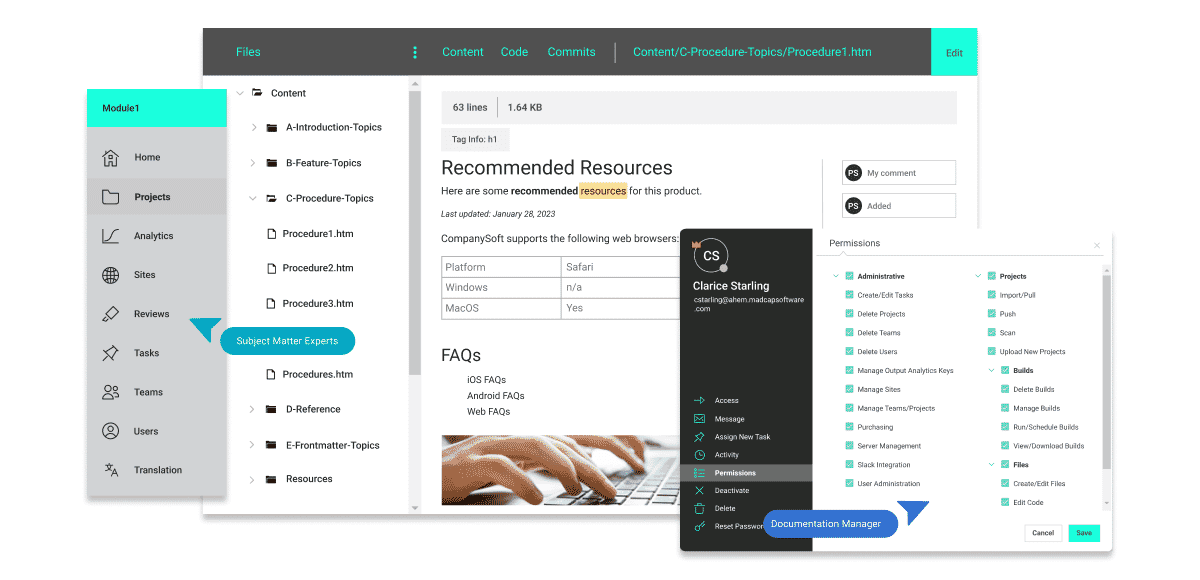This guest blog post was written by Trey Smith is a technical communication and content strategy innovator. After graduating from Mercer University with a degree in Technical Communication, he joined NCR Corp as a tech writer and grew to become a thought leader in the tech comm space. Trey is an advocate for single source writing strategies in enterprise level environments. He currently leads the content developers in Honeywell’s Building Technologies division and is driving the digital transformation of technical content.
Content Experience: The Bridge to Exceptional Customer Journeys
In the complex tapestry of modern business, content reigns supreme. Yet, content is more than just words on a page or videos on a platform; it's an intricate ecosystem that defines the customer journey. While the sale's culmination might seem like the final curtain call in this theater of engagement, the story doesn't end there. It's the nuances of the content experience—before, during, and post-sale—that can elevate a brand from being merely transactional to becoming transformational. This intricate dance between technical content, customer needs, and strategic intent is what brings a brand to life, fostering loyalty that transcends a singular purchase. And to choreograph this dance, a robust framework is essential. To delve into the world of content experience as we explore its intricacies and unveil how it can reshape the entire narrative of customer relationships, we must first understand the understand the pillar ideas of a proper framework.
The 4 Pillars of the Content Experience Framework
Crafting a seamless content experience necessitates a comprehensive approach, which is encapsulated in the content experience framework. This framework rests on four pivotal pillars: Strategy, Structure, Scale, and Systems, all of which intersect with various facets of digital marketing, content marketing, and customer experience management.
1. Strategy
At the heart of the content marketing framework is a detailed strategy. This not only includes understanding and defining business goals like brand awareness but also deep diving into market research to identify the ideal customer. Establishing a marketing strategy involves pinpointing the objectives, from demand generation to enhancing customer loyalty, and then setting clear metrics to measure success. Utilizing customer data, buyer personas come to life, ensuring content resonates with potential customers and guiding them through the buyer journey.
2. Structure
Great customer experience is anchored in well-structured content. This isn't just about content creation but ensuring that existing content is organized in a way that mirrors the customer journey map. A well-defined content audit, complemented by customer journey mapping, ensures content meets customer needs at every stage. By maintaining a coherent taxonomy and content management system, marketers ensure that content ideas are easily accessible, tagged consistently, and can be tailored for personalization, leading to enhanced customer satisfaction.
3. Scale
As the realm of digital marketing expands, the imperative to scale and reuse content across various channels, from social media to automated email campaigns, becomes paramount. Marketing automation tools facilitate this, driving demand generation by repurposing modular content pieces to fit diverse contexts. In the age of feedback-driven improvements, integrating customer feedback into content scales ensures the content marketing framework remains robust and responsive.
4. Systems
In the nexus of content and customer experience lies technology. Deploying platforms that do more than just host content, but also gather customer insight, is crucial. By leveraging analytics and customer feedback, brands can refine their CX strategy, ensuring alignment with broader marketing goals and enhancing customer relationships. Analytics, combined with success stories, become invaluable in this endeavor, offering a clear roadmap for businesses to create a great customer experience. This is what something like MadCap Flare helps do with it’s robust analytics across your content, helping inform your strategy.
Working closer together
The sale is complete, the excitement is over, and the deal is closed. That is the final step of the content experience journey… Or is it? Have you thought through your full content experience ecosystem for before, during, and after the sale? This is when your technical content experience can take your whole customer experience from good to great. But it takes a different strategy and focus on supporting your customer, and often it could be a year (or, in the case of some of the fields I have worked in, decades) long strategy. How do you build a sustainable content ecosystem and a robust content experience? This series will walk you through what needs to be done from sale to end-of-life. Let’s start with what happens during to right after the sale.
Work smarter, not harder
Your goal in developing a full content experience framework is understanding the 10,000 ft view. Your organization (particularly in the enterprise space) will most likely have the job functions for each stage of the content experience broken down into different areas of the business. Still, they will likely fall into one of the following three categories, copywriters, technical writers, and technical support. Each of those areas of content developers will provide a unique perspective and provide their skills at different stages of the customer journey. But that should not mean the customer experience is wholly different. This is where content strategy and information architecture come in.

The goal should be for each of these functional areas to leverage each other’s work. This is known as content reuse. From my experience, this concept has lived in the technical writing space for many years and can be seen in other functional areas as well. However, sharing content across functional areas does not freely occur without proper coordination and preparation between the various teams. A full content marketing strategy is key to putting together a complete content experience.
Developing content in a reusable way is the next evolution in customer experience, and those teams and organizations that can learn to master these methods will set the bar for the next generation of content development. By sharing information and content as it is created, it will help spread the knowledge within and throughout your organization. This means writing or creating content in a modular way. Some may refer to this as topic-based authoring, but it is time to think beyond even topics. The goal needs to be consumable content. What will be easily used and shared between teams? Can it be found quickly? Is it tagged correctly with accurate metadata? These are all parts of the ever-complex writing ecosystems we live in today. But once mastered, it opens many opportunities to create or complement each other’s content.
Let’s play “Name That User!”
As I mentioned previously, there are generally three different content development areas for complex enterprise solutions. Each represents a different part of the business and a different stage of the content experience ecosystem.
First is the Copywriter, who represents the Marketing portion of the business. This has been the traditional focus of content strategy and customer experience. They help develop the content that the prospective customer will see first. It could take the form of a blog or a white paper. Copywriters also develop sales collateral for the sales team to market the product. The content strategy and audience will vary depending on the product and the market. Generally, the content used in this area will be more generalized and conceptual to speak to the busy executive or user looking to solve a problem that someone else in the organization knows about. (If you have ever hung around the E suite for any reason, you know the types of individuals I mean. They need a solution, and they need it yesterday, but it better not cost a lot!) In most enterprise environments, the creative team will use some form of Content Management System (CMS/CCMS).

This doesn’t mean that the content needs to stay generalized. In fact, part of your new content experience strategy could be to leverage more accurate technical content into your copy. By using concepts like content chunks (also known as a snippet in the Madcap Flare space), a copy developer could grab that complex information and plug it directly into the white paper or datasheet. And if that data ever changes (which never, ever, ever happens. Ever. Right?), it can be adjusted in one place, and the content will then update across the whole content ecosystem.
Next, let’s look at the customer journey after the sale. The next stage will be the team that is implementing or installing the solution (the one Mr. Executive knew best to buy) will be looking into the technical support information. They might be old school and call the tech support hotline, or if they are a digital native (such as myself), also known as a millennial, they will be heading straight to the support page (or Google or ChatGPT) to figure out how the heck the new solution works. This means the content experience needs to be top-notch in the space of knowledge articles and technical support information. They won’t be looking for higher-level content or copy. They will look for common use cases, similar user experiences, and specific technical information to get them up and running with the solution (or find out if it will solve the problem). This means creating and developing accurate knowledge articles and tracking previous users’ input. Depending on the industry, this type of support could take on many forms. But, having a Knowledge Management System (KMS) is a key part of keeping things under control.
You may have noticed I skipped over the technical writer, which represents the research or engineering branch of the content ecosystem. They are also the technical content that holds the whole experience together like glue. Or helps best explain how the product can be used, sold, or fixed. The champions of content. The unsung Avengers of engineering. The Jedi of communication… Okay, so I might be a little biased here, being a professionally trained technical communicator/content developer for much of my career. But I do stand by my claim, if you can find a high-quality technical author, you will learn all you need to know about the product or solution. This means the tech content developer will support both the copywriter and technical support team with the content they research and gather from the engineering and product development teams. You could think of them as the source of knowledge about the product. Although they may not be creating the product, many times they are one of, if not the first, to use the solution.
This brings us back to the start with content reuse. By gathering all the information in a single location, and having it tagged in an effective manner, all three content development groups can share information and provide a unified experience.
Putting a plan into action
Let’s now look at what that ecosystem could look like in practice. For the purpose of this post, we will be looking at the processes and tools needed on the back end rather than the customer perspective. The reason is that most leaders like Mr. Executive do not realize the amount of backend infrastructure that is needed to create a seamless, intuitive customer experience. Besides, how hard can writing and posting a content set be?

The first step is establishing a process to connect all the teams. I suggest having a regular meeting between the different content creation functions. This could be in the form of a group or guild. I have helped implement a few of these more general groups throughout my career. Breaking them into two focus types helps. The first is the more general group that meets monthly and ensures everyone is on the same page. The second is a group I refer to as a Community of Practice. This group has a singular goal, like creating a commonly used content template, and may meet more often with a core set of members. They will then present their findings to the more extensive creator’s group. This is a great approach to divide and conquer.
The second step is a bit more complicated and will require buy-in from leadership; Building an entire ecosystem with the right tools. Establishing a commonly used toolset that can share content easily is key. This could be a combination of tools, but a central connecting point will almost always be a type of Content Management System (CMS, CCMS, or KMS). Depending on the legacy infrastructure, getting everyone to use the same CMS may be a bit more complicated. Still, the more centralized an enterprise can become the more powerful methods of content sharing can be used.
Lastly, don’t overlook the need to architect out the CMS structure and Constant Integration Constant Delivery (CI/CD) process for delivering content. This is no small feat to define and establish. Building a sustainable process will take time in established environments, so be prepared for a journey. Focus on small parts and build a solid foundation for developing content that uses modern structures for content reuse within each area first. Integrating the three functions will happen naturally if each group begins moving to the center, one Community of Practice at a time.
Remember, each journey starts with a single step, and creating a unified content experience is no different. Establish a vision of where you want to be and find the small stepping stones to get there. If you want to learn more about the journey, I am leading my team on, be sure to attend my presentation at MadWorld 2023. I will discuss in more detail how to create champions for technical content, get the tools you need, and what challenges we have faced and conquered along the way, so you don’t have to.










